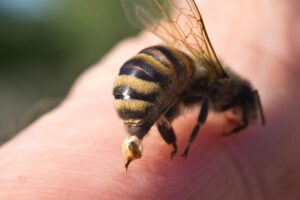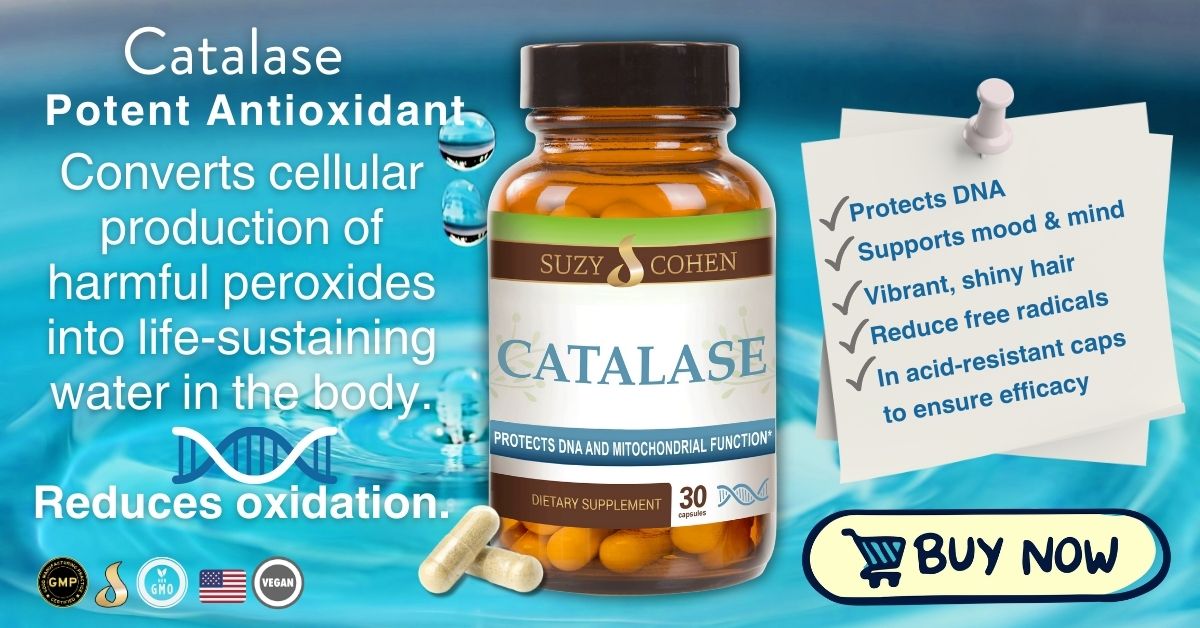What's On This Page?
ToggleEvery few years, an old remedy rises from the pages of history and finds new life on wellness blogs and social media feeds. Right now, that spotlight belongs to bee venom therapy—also called apitherapy. The practice isn’t new, it dates back thousands of years to ancient Egypt, Greece, and China, where bee products like honey, propolis, and venom were used in traditional healing rituals. Fast-forward to today, and bee venom therapy is b eing repackaged as a cutting-edge “natural” solution for modern ailments.
eing repackaged as a cutting-edge “natural” solution for modern ailments.
But just to be clear, about 5 to 7.5 percent of the US population is allergic to insect stings (bee, wasp, hornet, yellow jacket). Of those, around 2 percent may experience life-threatening anaphylaxis at some point. In the U.S., insect stings (including bees) cause an average of 60 to 70 deaths per year, according to the CDC so before you get too excited keep that in mind.
Supporters claim it can ease arthritis, multiple sclerosis, and chronic pain, while others whisper about its potential in cancer treatment. Online forums are filled with dramatic testimonials, and you’ll even find beauty companies adding bee venom to creams and serums, promising everything from wrinkle reduction to a youthful glow. It all sounds intriguing, and it makes for sensational headlines.
But the buzz comes with a sting. Before you start chasing bees in your backyard or ordering “miracle” products online, it’s important to pause and separate hope from hype. Bee venom therapy is experimental, risky, and far from the cure-all some claim it to be. Here’s a paper from the National Library of Medicine that you might be interested in. And in my article, I’ll walk you through five critical factors that everyone should understand before considering bee venom therapy. Before we get to that, let’s talk about propolis for a minute.
Propolis vs. Bee Venom Therapy
It’s easy to lump all “bee products” together, but propolis and bee venom couldn’t be more different.
Propolis is a sticky resin bees collect from tree buds and bark, mixing it with their own enzymes to seal and protect the hive. For humans, it has long been valued for its antimicrobial and antioxidant properties. People take propolis in capsules, tinctures, or lozenges, and it’s even used in natural toothpaste and throat sprays. The safety profile is generally good—most people tolerate it well, though mild allergies can occur in sensitive individuals. Importantly, there’s a body of research showing propolis may support immunity, wound healing, and oral health.
Bee venom therapy, on the other hand, involves exposing the body directly to venom – either through intentional stings, injections, or creams. Unlike propolis, which is protective and soothing, venom is designed by nature to defend the hive by causing pain and inflammation. Researchers are studying its peptides like melittin for potential benefits, but the evidence in humans is still weak. The risks, however, are clear: pain, swelling, allergic reactions, and even life-threatening anaphylaxis.
So while both come from the hive, propolis is more of a gentle ally with centuries of safe use, whereas bee venom therapy is still experimental, unproven, and potentially dangerous.
1. Research is still experimental. Melittin, the natural peptide in bee venom, is what causes the immediate pain you feel after a sting. In Australia, researchers found that melittin could disrupt the EGFR/HER2 growth pathways that cancer cells depend on. It leaves healthy cells pretty much unscathed. The findings are preliminary, limited to test tubes and animals, and not proven in people. Even the American Cancer Society cautions there’s no scientific evidence that apitherapy alters the course of cancer.
2. There are serious risks. If you have severe allergies (like to food, latex, or drug allergies), you may have a more “reactive” immune system and therefore would have a higher risk of developing a bee venom allergy too. Anaphylaxis can strike suddenly, even if you’ve never had problems with bee stings before. It’s a medical emergency that can shut down your airway and blood pressure within minutes. Tragically, there are documented fatalities from bee stings. If you’re allergic to wasps or other insect stings, you may also react to bee venom.
3. It’s not FDA-approved. Bee sting therapy isn’t approved by the Food and Drug Administration. That means licensed physicians cannot legally prescribe it as a treatment for cancer or any other disease. Some naturopaths or alternative practitioners may offer it, but it’s outside the scope of conventional medicine. This doesn’t make their intentions bad, but it does mean you’re on your own if something goes wrong.
4. It’s an ancient practice. Ancient Egyptian, Greek, and Chinese texts all describe the use of bee products for healing. Today, enthusiasts are experimenting with three main approaches. One is deliberate bee stings (sometimes dozens at a time!). Another is injectable venom offered by alternative clinics abroad. The third option is administered via topical creams or serums but that doesn’t work well. While it sounds exotic, none of these are part of mainstream medicine in the United States, although some places do it under the radar.
5. There are ethical concerns. Bee sting therapy ends in the death of the bee, since honeybees die after stinging. Given the importance of bees to our food supply and ecosystems, this raises ecological and ethical questions. I’m only listing it for your consideration because these consequences matter to some people, and not to others. (Speaking of honeybees and honey… you may not know which is the best honey for you, especially if you have allergies or food sensitivities. Read this article: The Best Honey for Allergies: Raw Unfiltered vs. Pasteurized Comparison

The Hype vs. The Hurt
When you read about bee venom online, it sounds like a miracle waiting to happen. Beauty magazines gush about venom serums that “sting the wrinkles away,” while alternative forums share glowing stories of pain vanishing after a few sessions of sting therapy. Want a serum that actually works? Consider my facial serum which contains Neodermyl®, Saliporin, hyaluronic acid as well as SYN-COLL collagen peptides that is guaranteed to make a difference in 30 days! Check out Collagen Beauty Peptide Serum.
It’s easy to get caught up in the buzz—especially if you’ve been living with something stubborn like arthritis, MS, or chronic fatigue. I get it. When you hurt, hope looks attractive in any form, even if it comes with a stinger.
But here’s the rub: melittin, the active compound in bee venom, is what makes your skin burn right after a sting. It’s not some gentle healer – it’s literally a toxin! Yes, in laboratory settings, melittin has shown promise against cancer cells. In one Australian study, it disrupted the EGFR/HER2 pathways that certain tumors depend on, and that’s exciting science.
But outside of a petri dish, in the messy world of human bodies, things aren’t nearly as clear.
Meanwhile, the risks are very real. Pain and swelling are the mild side effects. On the severe end of the spectrum, one unexpected sting can land you in the ER with anaphylaxis. That’s not scare-mongering, that’s medical reality. According to the CDC, dozens of Americans die every year from insect sting reactions, and not all of them knew they were allergic. Read my article on Neffy® which is a nasal spray for ANAPHYLAXIS.
So, is bee venom therapy the fountain of youth? A natural anti-cancer weapon? A miracle pain reliever? Maybe in headlines, yes. But in real life, it’s more like rolling dice with your immune system. And in my opinion, you shouldn’t gamble with your life when safer, more proven therapies are out there.
Final Buzz: What You Should Remember
Bee venom is fascinating, and I agree the research deserves continued attention. There may indeed be something valuable within melittin and other compounds that science will one day harness for safe, effective treatments. But right now, it’s still in the experimental stage – unproven, not necessarily safe, and certainly not FDA-approved.
The word “natural” often gives people a false sense of security, but natural does not always equal harmless. Bee venom can trigger severe reactions, ranging from pain, swelling, and blistering to dangerous allergic responses that can become life-threatening within minutes. Even repeated small exposures can lead to long-term skin irritation or the sudden onset of allergy later in life.
So before you let a hive become your health plan, weigh the real risks against the unproven benefits. If you’re interested in bee products for wellness, there are safer options, like honey or propolis that have a long history of use and research to support them. Bee venom therapy, however, is not ready for prime time.
Related article: Propolis is Perfect for Immune Function, Blood Sugar and Cholesterol

Suzy Cohen, has been a licensed pharmacist for over 30 years and believes the best approach to chronic illness is a combination of natural medicine and conventional. She founded her own dietary supplement company specializing in custom-formulas, some of which have patents. With a special focus on functional medicine, thyroid health and drug nutrient depletion, Suzy is the author of several related books including Thyroid Healthy, Drug Muggers, Diabetes Without Drugs, and a nationally syndicated column.


